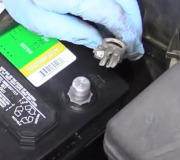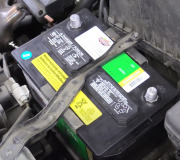Nope. A battery charger for car batteries is designed to produce up to a specified amount of current at approximately 14 volts. There is nothing in them to get weak from age or use, but there are parts that can fail causing them to not work or to be unable to reach that maximum current. If you have a 20 amp charger, it will always be capable of developing up to 20 amps.
The first point of confusion is when trying to charge a totally dead battery. It can take as much as fifteen minutes for the acid to become electrically conductive to where the battery will start to take a charge. That means the amp meter will stay near 0 amps at first, then slowly rise as the battery starts to take a charge. By 15 to 30 minutes the charge rate will be closer to 15 amps, which is a good maximum rate. As the battery reaches full charge, the current will slowly decrease. We figure a battery is near fully-charged when the current drops to around five amps.
To compare this to water, suppose you have a water pump that is sending water up into a municipal water tower. The weight of the water in the tower provides the pressure to send it out the pipes to our homes. If that is 100 pounds, to make more water flow up into the tower, you need more than 100 pounds, otherwise the water wouldn't move. We will say the pump is regulated to develop no more than 105 pounds of pressure.
Once some of the water is drawn out of the tower, the weight of what remains, and therefore the pressure, goes down, perhaps to 90 pounds. Now there is a 15 pound difference over what the pump develops, so more water flows faster into the tower. It does not take long to get the pressure back up to 100 pounds. If the pressure reaches 105 pounds in the tower, no more water will flow up into it.
In a car, a fully-charged battery will measure 12.6 volts. (Voltage is electrical pressure and is what causes current to flow). The generator is regulated to develop between 13.75 and 14.75 volts. That higher voltage will cause current to flow into the battery. Once the battery reaches 12.6 volts, meaning fully-charged, the 2.0 volts extra from the generator isn't really enough to cause more current to keep flowing into it. If the voltage were to be higher, the additional current will eventually cause the plates in the battery to heat up. That will heat the acid and tend to boil the water out of it. At less than 13.75 volts the battery will not be forced to take on a full charge. That's why there is such a narrow band of acceptable charging voltage.
One of the basic steps in testing the car's charging system is to measure the battery's voltage while the engine is running. You should find that 13.75 to 14.75 volts. But understand there's a lot more to the tests. Passing this voltage test simply means it's okay to do the rest of the tests. That requires a professional load tester.
Getting back to your charger, there are a number of things to be aware of. The first one I mentioned already has to do with it taking some time before the battery starts to take a charge. Once you see the amp meter come up to ten to 15 amps, it will take a good battery up to an hour to fully charge.
The second problem is bad connections at the clamps. You may need to wiggle and squeeze them a little. If the amp meter jumps a little, when it goes to 0 amps is when there's a bad connection. Keep wiggling until the meter shows some charging is taking place. There will be some small sparks, so be careful. More on this later.
There is a less-known problem related to using battery chargers that pertains more to batteries that are a few years old. Generators, ("alternator" is the more common term, but that was copyrighted by Chrysler), produce high-frequency three-phase output. Without going into a lot of detail, three-phase output current is very smooth and steady which is good for charging a battery and running electrical systems. Battery chargers make use of low-frequency single-phase output that is "rectified" house current. House current is perfect for the types of things it is expected to run, but in a battery charger, that charging current will go from 0.0 amps to maximum current, then back to 0.0 amps 120 times per second. That pulsing current will cause the plates in the battery to vibrate. The higher the current, the harder the plates will vibrate. After a few years the lead starts to flake off the plates and gets deposited in the bottom of the case. As more and more lead flakes off, the capacity of the battery goes down. It might still crank the engine just fine, but it can only do it for a total of perhaps 20 seconds instead of 60 seconds like it could when it was new. Also, when enough lead flakes off that it builds up in the bottom and touches the plates, that cell becomes shorted and the battery has failed.
Charging the battery with a portable charger at a high rate will not cause a battery to fail. It will hurry up the inevitable failure and make it occur sooner. That is why a fast charge is okay to get a car with a dead battery started right now, but for general maintenance, always leave the charger on a lower setting. Some wheel-type chargers are capable of reaching over 50 amps. That will greatly shorten the life of that battery.
Because there is going to be a difference in voltage between the battery and the charger, that will cause a spark to occur when the final connection is made. Batteries give off highly-explosive hydrogen gas and those sparks could cause the battery to explode. To avoid that, always have the charger turned off when you are connecting it to the battery or when disconnecting it. Always wait to turn the charger on until after it is connected. Conscientious mechanics wear safety glasses when working around car batteries, and people who maintain a large stock of batteries at retail stores usually also wear a face shield. Battery explosions are very rare, but that is because we are careful around them.
As far as "does not work very well any more", portable chargers use "diodes" to change the alternating power line current into direct current that can be stored in a battery. A diode is simply a one-way check valve for electrical current. All generators have at least six of them, two for each of the three phases. A portable charger only needs one to do its thing, but diodes are relatively cheap, and adding a second one doubles the current the charger can develop, and therefore increases what the manufacturer can sell their product for. The efficiency and maximum output can be doubled again by using four diodes, which is what most chargers have. If one of those diodes were to short, it would kill half of the current-generating capacity of the charger. If you have a 30-amp charger, 15 amps is the most you would ever get from it. The confusing part is you will ALSO get less than the maximum rated current when the battery nears a full charge, so sometimes it's hard to tell if the charger is working right. Fortunately those diodes don't fail very often.
Saturday, June 18th, 2016 AT 9:08 PM




